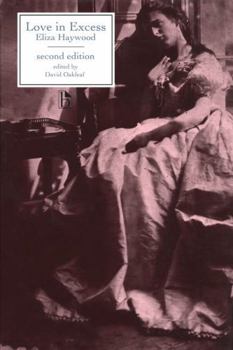Love in Excess - Second Edition
Select Format
Select Condition 
Book Overview
Eliza Haywood (1693-1756) was one of the most successful writers of her time; indeed, the two most popular English novels in the early eighteenth-century were Robinson Crusoe and Haywood's first novel, Love in Excess. As this edition enables modern readers to discover, its enormous success is easy to understand. Love in Excess is a well crafted novel in which the claims of love and ambition are pursued through multiple storylines until the heroine...
Format:Paperback
Language:English
ISBN:1551113678
ISBN13:9781551113678
Release Date:June 2000
Publisher:Broadview Press Inc
Length:296 Pages
Weight:0.80 lbs.
Dimensions:0.6" x 5.5" x 8.4"
Customer Reviews
4 ratings
Could have been trashier
Published by Thriftbooks.com User , 19 years ago
It seems everyone always wants to pinpoint the "first novel." It's not Pamela, it's Love in Excess. It's Love in Excess, it's Gulliver's Travels. It's not Gulliver's Travel's, it's Oroonoko. Actually, the first novel is probably Gargantua and Pantagruel by Rabelais. Or Don Quixote. Either way, it's not in English. And when it comes down to it, it doesn't really matter. Love in Excess (and the others around it) should be judged on its own merit, not in chronological/"novelistic" relation to other supposed "first novels." So, judged on its own merit, is Love in Excess any good? Well, first of all, it's highly theatrical, in multiple senses of the word. Eliza Haywood was a successful actress and the novel is dedicated to a big former stage star of the day. (It'd be like a book being dedicated to Julia Roberts today.) The novel is composed in three highly-differentiable parts - they seem like they could be three acts in a play. The characters are often easily placed into types - one could imagine one person playing three of characters of the same type (e.g., the deceitful woman) that each appear in a separate part/act. Love in Excess is, fundamentally, about exactly that - what happens when too much "love" is shooting around everywhere. Love, lust - whatever. Haywood delves deeply into what love is, and it's a very different notion than what we have. Probably few people today read Love in Excess for its plot, but the story is worth it - convoluted, ridiculous, at points hilarious, full of outrageous coincidences, trashy, and by the standards of the day surely damn near pornographic. The syntax takes a little getting used to, but the book flows well as it goes on. The main fault of Love in Excess to the modern reader, though, is that it's not saucy *enough.* Compared with romance novels (that phrase was once oxymoronic, but I think it makes sense even in relation to Love in Excess) today, you're left with a bit of the "That's it?" feeling. (Still, by the standards of the day...)
The first novelist & very much misunderstood
Published by Thriftbooks.com User , 21 years ago
It's a shame that Richardson gets credit for being the first novelist--Haywood wrote "Love in Excess" twenty years prior to "Pamela"!!! And frankly, I think "Love in Excess" is not only a much better novel in terms of its craft and general use of language, it is also much more entertaining--which was the aim of many early novels anyway."Love in Excess" is a bawdy, surprisingly complex romp. What you have, I think, are morally ambiguous characters; some are just flat-out amoral; and the fun and playful thing about EH is that she treats her characters as consistent, moral creatures, yet they are far from it. Indeed, for those that read EH as simply a romance writer, they're missing out on a wealth of sarcasm, satire, and humor. EH knew she was creating despicable people; she wanted to point out the absurdities of courtly love; and by writing in a tone that is seemingly serious, she is also testing her audience. Even though this was the first novel, Haywood understood how to write both to the masses and to her peers. In other words, "Love in Excess" is multi-functional and sets a standard for those like Richardson to follow--who, hypocritically, I'd imagine, would deny her influence and dismiss her talents because of her gender. It's wild that Haywood is hardly known: she's a master writer, a brilliant social commentator, and in possession of a tremendous analytical mind. I admire her very much.
Not for Austen fans necessarily, but a good read
Published by Thriftbooks.com User , 24 years ago
Austen fans would be advised to read Haywood's History of Miss Betsy Thoughtless, not Love in Excess, which is a much earlier "novel" following the fortunes of a male protagonist through a series of increasingly bizarre romantic twists and tangles. It's a fast read and quite enjoyable, but be prepared for some serious nuttiness.
One of the Best Novels of the 18th (or any) century
Published by Thriftbooks.com User , 25 years ago
If you like Jane Austen, you'll really like Love In Excess. It is both a humorous and exciting tale of loves lost, gained, regained, and unconsummated. The diversity of characters really makes this book intriguing. You never know who will do or say what , and if you think you do, you'll be wrong. What will be surprising to readers of Austen or Burney is the amount of control the female characters have over their own fate. In a Burney novel, for example, events tend to happen to the female characters rather than the character shaping the events. This isn't the case with Love In Excess. The women in this novel are very much active in their own circumstances, whether for good or ill. Love in Excess deserves your attention. In the first half of the eighteenth century the only novel to out sell it was Daniel Defoe's Robinson Crusoe, which suggests to me that scholars should give it more attention for its importance in the development of the English novel. Regardless, scholarly reader or escapist will enjoy this book.






